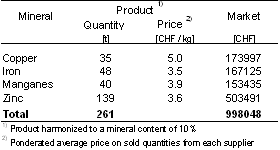Organic trace mineral market in Switzerland

A market survey was conducted in Switzerland to evaluate the use of organic copper, iron, manganese and zinc.
Organic forms of trace minerals are generally considered as more bioavailable than inorganic sources. A limited number of data is available to evaluate the market of those products.
All major suppliers of these products were contacted in Switzerland and sales figures for the year 2009 were kindly provided to Agroscope Liebefeld-Posieux ALP.
In addition, to these sales figures for each mineral, the suppliers were asked to evaluate the proportion of zinc sold for ruminant nutrition.
Zinc was used, as its native content in feeds is, in most cases and in contrast to the other three minerals, not sufficient to meet the requirements of all major species (ruminants, swine and poultry) present in the country.
Zinc is therefore widely supplemented and will permit to evaluate the presence of organic zinc sources in ruminant and non-ruminant nutrition.
Survey result
The used organic trace minerals in Switzerland had either amino acids (glycine) or hydrolyzed soy proteins as ligand.
Polysaccharides were not present on the market. Their mineral content varied between 10% and 26% depending on product brand and mineral. To make the market analysis possible, mineral contents of all products were harmonized to 10%.
Overall 260 t of organic trace minerals (10% mineral content) were used in Switzerland during 2009. These products represented a market which reached closely 1 mio CHF (Table below).
Products with glycine as ligand represented, on average, 45% of the quantity and turnover compared to products with hydrolyzed soy protein as ligand.
The mostly used mineral was zinc as it represented 53% of the total quantity and 50% of the market (Figure below). The other three minerals shared the other half equally.
With regards to zinc specifically, 60% of the organic zinc was provided to ruminants and 40% to non-ruminants (poultry, pigs).
This proportion was however highly different from one supplier to another. For the ruminants and non-ruminant feed business, zinc supplementation in organic form represents respectively about 15% and 20% of the estimated total investment in zinc supplementation.
However, the organic sources of zinc represent less than 10% on a quantitative basis as they are more costly than inorganic sources.











